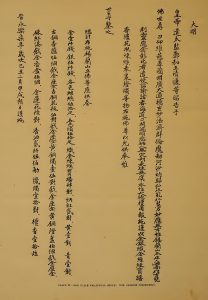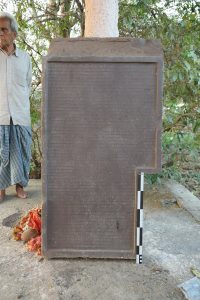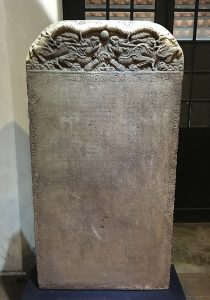IN03162 Poḷonnaruva Fragmentary Slab Inscription of Sundara-Mahādevī
This inscription is engraved on a stone slab discovered in 1931 by the Archaeological Department during the restoration of the ruined maṇḍapa built on a three-tiered platform near the Royal Palace of Parākramabāhu I at Poḷonnaruva. This maṇḍapa was identified by A. M. Hocart with the Rājaveśyā-bhujaṅga-maṇḍapa, mentioned in the Mahāvaṁsa as having been built by Parākramabāhu I. In the course of the Archaeological Department’s restoration work, it was discovered that the builders of this structure had utilised several earlier inscribed stones for the steps, mouldings and coping stones. Evidence was also found that the building had been substantially repaired at a later date, probably during the reign of Parākramabāhu II. It is therefore not certain whether the inscribed stones were used in the initial construction of the building or whether they were introduced as part of the subsequent repairs. The slab bearing the present inscription was used for the coping on the eastern side of the lowest tier of the platform. A large part of the inscription was effaced, perhaps deliberately, when the slab was utilised for this new purpose. Originally, the record must have consisted of around 45 lines but now only the first seven are legible. These lines are not enough to determine the subject matter and purpose of the inscription. The first two lines contain a Pāli stanza eulogising a thera named Ānanda, who is said to have had some connection with the Buddhist Church of Tambaraṭṭha, possibly referring to a place in the Coḷa country in Southern India or to Nakhon Si Thammarat in the Malay Peninsula. The next five lines introduce us to Sundaramahādevī, the queen of Vīkramabāhu I (r. 1111–1132 A.D.), who was the son of Vijayabāhu I (r. 1056–1111 A.D.).
OB03128 Gaḍalādeṇiya Slab-Pillar
Gadaladeniya Vihara, Kandy, Sri Lanka
IN03155 Gaḍalādeṇiya Slab-Pillar Inscription
This inscription is engraved on a slab pillar, which now stands outside the main entrance of the Gaḍalādeṇiya Vihārē, a foundation of the fourteenth century situated in Uḍunuvara of Kandy District. The pillar was set up in its present position by H. C. P. Bell, Archaeological Commissioner, who found it inside the temple. All four faces of the pillar are inscribed. On the front of the slab is a record dated in the fifth year of king Siri San̆gbō Śrī Jayavīra Parākrama Bāhu, which grants an amnesty to Mēṇavara Tuṇayan, nephew of the ǟpā Parākrama Bāhu of Doḍamvela, and the people of the Five Countries, on the reduction of the Hill Country then recently effected before the Coronation Festival held on the twelfth of the bright half of Vesak. This text is preceded on one of the narrow sides of the slab by the word Siddhi engraved beneath the sun and moon, a cakra and conch shell. On the reverse of the slab, continued on the other narrow side, is the undertaking of the rebels to be faithful to His Majesty; their leader is here called Mēṇavara Tuṇayārun. Codrington tentatively suggests that the king Siri San̆gbō Śrī Jayavīra Parākrama Bāhu of this inscription may have been Parākrama Bāhu IX, whose coronation took place in 1509 and whose reduction of the Hill Country is recorded in the Rājāvaliya. This would make the date of the inscription 30 September 1513.
IN03152 Galle Trilingual Stele – Chinese Inscription

Galle (Sri Lanka). Stele of Zheng He (鄭和), transcription of Chinese portion. (Zenodo).
The inscription is engraved on a stone slab discovered in 1911 by H. F. Tomalin, the Provincial Engineer at Galle, in a culvert near the turn to Cripps Road within that town and afterwards moved to the Colombo Museum. The slab features inscriptions in three different languages, enclosed within a floral border: Tamil (top-left, IN03150), Persian (bottom-left, IN03151) and Chinese (right). The Chinese inscription is dealt with here.
Following the discovery of the slab, the Chinese inscription was transcribed and translated by Edmund Backhouse. Like the Tamil inscription, it is dated in the second month of the seventh year of Yongle (永樂), the Chinese emperor whose reign began in 1403. The text features praise and offerings dedicated by the Chinese emperor, through his envoys Ching-Ho and Wang Ch’ing Lien, to the Buddha. The other two inscriptions on the slab feature similar lists of offerings but the beneficiary is different in each case, being a Hindu cult deity in the Tamil text and an Islamic saint or shrine in the Persian. It therefore appears that, when the Chinese arrived in Sri Lanka, they made gifts of equal value to several different religious traditions of the region and registered these gifts on the same stele.
OB03125 Galle Trilingual Stele of Zheng He (鄭和)
IN03150 Galle Trilingual Stele – Tamil Inscription
The inscription is engraved on a stone slab discovered in 1911 by H. F. Tomalin, the Provincial Engineer at Galle, in a culvert near the turn to Cripps Road within that town and afterwards moved to the Colombo Museum. The slab features inscriptions in three different languages, enclosed within a floral border: Tamil (top-left), Persian (bottom-left, IN0351) and Chinese (right, IN0352). The Tamil inscription is dealt with here.
Following the discovery of the slab, the Chinese inscription was successfully transcribed and translated by Edmund Backhouse. However, Rao Bahadur H. Krishna Sastri (Assistant Superintendent for Epigraphy, Madras) and J. Horrovitz (Epigraphist for Moslem Inscriptions in India) failed in their efforts to decipher the Tamil and Persian texts respectively. Sometime later, the Tamil inscription was transcribed and translated for the third volume of Epigraphia Zeylanica (1933: 331–341) by Senarath Paranativana, who benefitted from having access to Backhouse’s translation of the Chinese text.
Like the Chinese inscription, the Tamil inscription is dated in the second month of the seventh year of Yuṅlo (Yung Lo), the Chinese emperor whose reign began in 1403 A.D. The text tells us that the Chinese emperor, having heard of the fame of the god Tenavarai-nāyaṉār in Sri Lanka, sent to him, through his envoys Ciṅvo and Uviṅcuviṅ, various kinds of offerings, of which a detailed list is given. Paranavitana notes that Tenavarai is the Tamil name for Devundara (Devunuvara), a settlement near Matara on the southern coast of Sri Lanka which was the centre of a cult dedicated to a deity known as Uppalavaṇṇa. Sometimes like the Purāṇic Viṣṇy in the Hindu tradition, this god was sometimes styled in Sinhalese ‘Devundara Deviyo’, which can be rendered in Tamil as ‘Tenavarai-nāyaṉār’. The other two inscriptions on the slab feature similar (though not identical) lists of offerings but the beneficiary is different in each case, being the Buddha in the Chinese text and an Islamic shrine or saint in the Persian. It therefore appears that, when the Chinese gained political ascendancy over Sri Lanka in 1409, they made gifts of equal value to several different religious traditions of the region and recorded these gifts on the same stone.
Sohagpur Jain inscription of Ajayavarman dated year 1244

Sohagpur (District Hoshangabad, Madhya Pradesh). Jain inscription of Ajayavarman dated year 1244.
OB03120 Velmilla Slab of Sena III
IN03145 Velmilla Slab Inscription of Sena III
The inscription is engraved on all four faces of an irregularly shaped stone slab, which was discovered in April 1931 in a garden called Baṭatum̆bagahavatta in the village of Velmilla (Welmilla) in the Rayigam Kōraḷē of the Kalutara District. According to local tradition, the villagers long ago dug a large pit near the stone in the hope of finding buried treasure. Finding none, they buried the stone in the pit, where it remained until it was brought to the surface in the 1920s. The slab was broken in two before it was buried and it has since been further mutilated into four unequal parts, one of which is now missing. After visiting the village, Senarath Paranavitana felt that the inscription was of exceptional interest and had it removed to the Colombo Museum in order to preserve it from further damage.
The inscription is dated in the eighth year of king Mahasen Abhā (Mahāsena Abhaya) who, on palaeographic grounds, must be one of the three Senas who flourished in the tenth century. The regnal year precludes Sena IV, whose reign lasted for only three years, and the mention of the heir-apparent Udā (Udaya), son of Sirisaṅgboyi Kasub (Kassapa), rules out Sena V as, although named Udaya, the heir-apparent during his reign was a son of Mahinda IV. By process of elimination, the inscription may therefore by attributed to Sena III, whose reign according to the chronicles extended for nine years and whose mahapā (heir-apparent) was a prince named Udaya. The chronicles do not record this prince’s parentage but the present inscription suggests that his father was Kassapa IV, who was known by the title of Sirisaṅgbo and whose reign was close to that of Udaya III.
The purpose of the inscription was to grant the usual type of immunities to a pamuṇu land situated in Aruṅgam-peḷavaga and belonging to a person whose name is not completely preserved. It may of interest to note that there is a village called Aruggoḍa about four miles from the site where this inscription was found, which may be related to the place called Aruṅgam-peḷavaga in the record.

